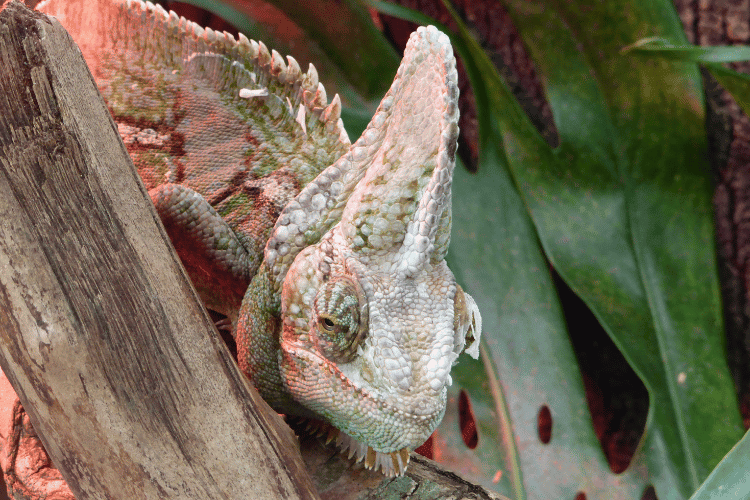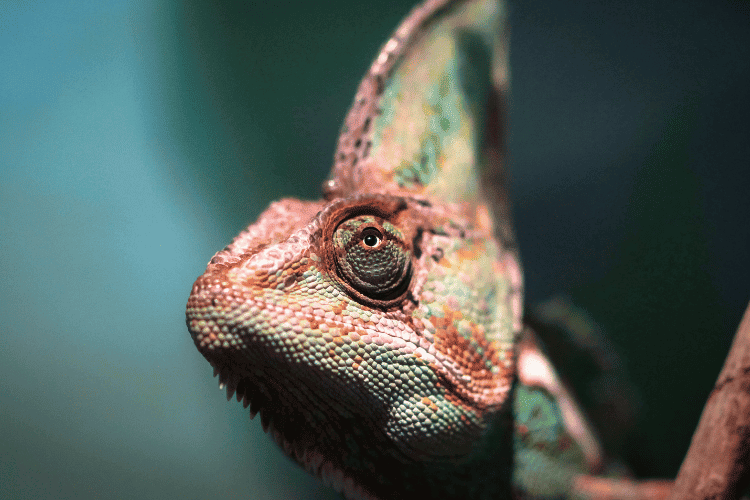Have you come across a veiled chameleon eye infection? If you’re lucky enough to have a veiled chameleon as a pet, you know how special they are. These amazing creatures are charismatic and can be quite playful. But even the most active and healthy chameleon can get sick from time to time.
If your chameleon develops an eye infection, don’t worry! With proper care and treatment, most chameleons make a full recovery. Just be sure to take your chameleon to the vet right away if you notice any signs of infection.
In the coming sections, you’ll find everything you need to know about veiled chameleon eye infections.
What Is a Veiled Chameleon Eye Infection?

Veiled chameleons have big cheeky eyes, and each one can move independently to help them spot prey. But what happens when those eyes get infected?
A veiled chameleon eye infection is a serious condition that can lead to blindness if not treated promptly.
The most common causes of eye infections are bacteria, viruses, and fungi. These infections can be caused by a number of factors, including trauma, malnutrition, and poor hygiene.
Symptoms of a Veiled Chameleon Eye Infection
Veiled chameleons are quite prone to eye infections. It’s important to be aware of the symptoms so that you can seek veterinary care promptly if your chameleon is affected.
Symptoms of a eye infection:
- Redness: One of the most common symptoms of an eye infection is redness. This can be caused by inflammation or blood vessels that have dilated in response to the infection.
- Swelling: Swelling in the eye or around the eye is another common symptom of infection. This is caused by fluid buildup due to inflammation.
- Discharge: Discharge from the eye can be a sign of infection, especially if it is thick, yellow, or green in color.
- Squinting: Chameleons may squint if their eye is sore or painful due to an infection.
- Loss of appetite: Chameleons with eye infections may lose their appetite due to pain or discomfort.
- Lethargy: Chameleons with eye infections may become lethargic or inactive due to pain or illness.
If you notice any of these symptoms in your veiled chameleon, it is important to take them to the vet right away. Early diagnosis and treatment of eye infections is essential for a full recovery.
How to identify an eye infection
Here are some additional tips for identifying a infection:
- Compare your chameleon’s eyes: If one eye is red, swollen, or discharging, it is likely that your chameleon has an eye infection in that eye.
- Look for signs of pain or discomfort: Chameleons may squint, rub their eyes, or avoid using their eyes if they are in pain.
- Monitor your chameleon’s behavior: Chameleons with eye infections may become less active, lose their appetite, or withdraw from social interaction.
If you are unsure whether or not your veiled chameleon has an eye infection, it is always best to err on the side of caution and take them to the vet. Early diagnosis and treatment is essential for a full recovery.
Causes of a Veiled Chameleon Eye Infection

Veiled chameleons are susceptible to a variety of eye infections, which can be caused by a number of factors. Here are some of the most common causes of chameleon eye infections:
- Bacteria: Bacterial eye infections are the most common type of infection in chameleons. They can be caused by a variety of bacteria, including Staphylococcus, Streptococcus, and Pseudomonas. Bacteria can enter the eye through a wound or scratch, or they can be spread through contact with an infected animal or object.
- Viruses: Viral eye infections are less common than bacterial infections in veiled chameleons, but they can be more serious. Some of the viruses that can cause eye infections in chameleons include herpesviruses and adenoviruses. Viral eye infections can be spread through contact with an infected animal or object, or they can be transmitted through the air.
- Fungi: Fungal infections are the least common type of eye infection in veiled chameleons, but they can be the most difficult to treat. Fungal eye infections are caused by fungi, such as Aspergillus and Fusarium. Fungi can enter the eye through a wound or scratch, or they can be inhaled and travel to the eye through the bloodstream.
- Trauma: Trauma to the eye, such as a scratch or puncture wound, can make a veiled chameleon more susceptible to eye infection.
- Vitamin and mineral deficiencies: Chameleons need a balanced diet to stay healthy. If a chameleon is not getting the nutrients it needs, it may be more susceptible to eye infection.
- Poor hygiene: A dirty cage or
water bowl can harbor germs that can cause eye infections. - Stress: Stress can weaken a chameleon’s immune system, making it more susceptible to infection.
If you notice any symptoms of an eye infection in your veiled chameleon, it is important to take them to the vet right away. The vet will be able to determine the cause of the infection and prescribe the appropriate treatment.
Treatment for a Veiled Chameleon Eye Infection

Veiled chameleon eye infections can be treated with a variety of methods, depending on the underlying cause of the infection. The most common treatments for veiled chameleon eye infections include:
- Antibiotics: Bacterial eye infections are treated with antibiotics, which are drugs that kill bacteria. Antibiotics can be administered orally, topically (to the eye), or by injection.
- Antifungals: Fungal eye infections are treated with antifungal medications, which are drugs that kill fungi. Antifungal medications can be administered topically (to the eye) or by injection.
- Saline solution: Saline solution can be used to flush the eye and remove any discharge or debris. Flushing the eye can help to reduce inflammation and promote healing.
- Supportive care: Chameleons with eye infections may need supportive care, such as fluid therapy and pain medication.
In some cases, surgery may be necessary to remove infected tissue or to repair a damaged eye.
Here are some additional tips for treating a veiled chameleon eye infection:
- Follow your veterinarian’s instructions carefully. It is important to complete the full course of antibiotics or antifungals, even if your chameleon seems to be improving.
- Keep your chameleon’s eye clean. Flush the eye with saline solution several times a day to remove any discharge or debris.
- Provide your chameleon with a clean and healthy environment. This includes cleaning your chameleon’s cage and
water bowl regularly. - Reduce stress in your chameleon’s life. Avoid handling your chameleon excessively and provide them with a quiet and comfortable place to rest.
With proper care and treatment, most chameleon eye infections can be cured. However, it is important to catch the infection early to prevent any complications.
Conclusion
Chameleons have amazing eyes. They can rotate their eyes independently of each other, which gives them a 360-degree view of their surroundings. So, it’s important to take care of those eyes!
Chameleon eye infections can be a serious condition, but they are often treatable with prompt veterinary care. By following some simple tips, you can help to prevent your chameleon from developing an eye infection in the first place.
One of the best ways to prevent veiled chameleon eye infections is to provide your chameleon with a clean and healthy environment. It is also important to feed your chameleon a balanced diet.
Finally, it is important to reduce stress in your chameleon’s life. Stress can weaken a chameleon’s immune system, making them more susceptible to infection. Avoid handling your chameleon excessively, and provide them with a quiet and comfortable place to rest.

